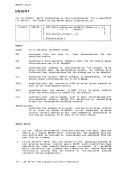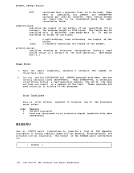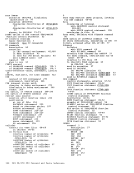FILEDEF • FILEDEF ddname DSN ? This form of the FILEDEF command allows you to specify the OS data
set name orDOS file-id interactively. Using this form, you can
enter anOS data set name or DOS file-id containing eBbedded special
characters such as blanks and hyphens. If you use this form, the
default filename and filetype for your file, FILE ddname, is theeMS filename and filetype associated with the OS data set name or DOS file-ide The filemode for this form is always the default, A1.
To use the interactiveDSN operand, you key in DSN 1; CMS then
requests that you enter the as data set name orDOS file-id exactly
as it appears in the data set or file. Do notoBit the periods that
separate the qualifiers of anOS data set name, but do not insert
periods where they do not appear.quall[ .guaI2 ••• 1
wherequall.quaI2... are the qualifiers of the JS data set DOS file-ide When you use this form, you must code the
separating the qualifiers• name or
periods• FILEDEF ddname mode DSN quaIl (quaI2 ••• ] This form allows you to specify the as data set name or DOS file-id explicitly. (This form can be used for DOS file-ids only if they
comply with the as naming convention of 1-to 8-byte qualifiers
separated by periods, to a maximum of 44 characters, including
periods.) Again, the default value for the filename and filetype is
FILE ddname.When you use this form, you must omit the periods that
separate the qualifiers of the os data set name. For example, for an
os data set orDOS file named MY.FILE.IN, you enter:
FILEDEF ddname BlDSN MY FILE IN
All of these forms have many variations, as is apparent from the
command format.
ddnamel device 1 rfilenamel filetypel filemodel[ da tasetnam e) ]
ddnameN deviceN [filenameN filetypeN filemodeN [ da tasetname]]
A list of current definitions is displayed if the FILEDEF command
is entered with no operands.DMSFLD069I DISK 'mode' NOT ACCESSED The specified disk is not accessed; the file definition remains in
effect. You should access the disk before you attempt to read or
write the file.DMSFLD220R ENTER DATA SET NAME:
A FILEDEF command with theDSN 1 operand was entered. Enter the
exactOS or DOS file identification, including embedded periods and
blanks.Section 2. CMS Commands 95
set name or
enter an
characters such as blanks and hyphens. If you use this form, the
default filename and filetype for your file, FILE ddname, is the
To use the interactive
requests that you enter the as data set name or
as it appears in the data set or file. Do not
separate the qualifiers of an
periods where they do not appear.
where
separating the qualifiers
periods
comply with the as naming convention of 1-
separated by periods, to a maximum of 44 characters, including
periods.) Again, the default value for the filename and filetype is
FILE ddname.
separate the qualifiers of the os data set name. For example, for an
os data set or
FILEDEF ddname Bl
All of these forms have many variations, as is apparent from the
command format.
ddnamel device 1 rfilenamel filetypel filemodel
ddnameN deviceN [filenameN filetypeN filemodeN [ da tasetname]]
A list of current definitions is displayed if the FILEDEF command
is entered with no operands.
effect. You should access the disk before you attempt to read or
write the file.
A FILEDEF command with the
exact
blanks.






















































































































































































































































































































































































































